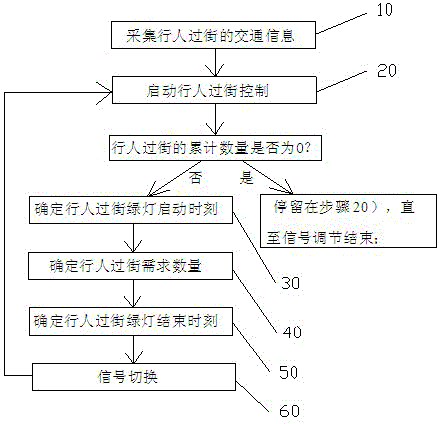Signal regulating method for pedestrian crossing road section of bus prior passage
A technology for pedestrians crossing the street and public transport vehicles, which is applied in the traffic control system of road vehicles, traffic control systems, instruments, etc., and can solve the problems affecting the reliability and stability of public transportation, the smooth operation of urban traffic systems, actual connection and linkage design Few methods involve issues such as
- Summary
- Abstract
- Description
- Claims
- Application Information
AI Technical Summary
Problems solved by technology
Method used
Image
Examples
Embodiment Construction
[0026] Below in conjunction with accompanying drawing, the present invention will be further described.
[0027] Such as figure 1 As shown, the signal regulation and control method for the pedestrian crossing section of the bus vehicle priority passage of the present invention comprises the following steps:
[0028] Step 10): Collect traffic information of pedestrians crossing the street. Step 10) includes step 101) and step 102).
[0029] Step 101): collecting static data, pedestrian crossing speed and dynamic real-time data. Among them, the static data includes: the length L of the pedestrian crossing, the width W of the pedestrian crossing, and the signal cycle duration C of the first intersection upstream of the pedestrian crossing 1 , the signal phase number i of the first intersection upstream of the crosswalk 1 , The signal cycle duration C of the first intersection downstream of the crosswalk 2 and the number of signal phases i at the first intersection downstream...
PUM
 Login to View More
Login to View More Abstract
Description
Claims
Application Information
 Login to View More
Login to View More - R&D
- Intellectual Property
- Life Sciences
- Materials
- Tech Scout
- Unparalleled Data Quality
- Higher Quality Content
- 60% Fewer Hallucinations
Browse by: Latest US Patents, China's latest patents, Technical Efficacy Thesaurus, Application Domain, Technology Topic, Popular Technical Reports.
© 2025 PatSnap. All rights reserved.Legal|Privacy policy|Modern Slavery Act Transparency Statement|Sitemap|About US| Contact US: help@patsnap.com



